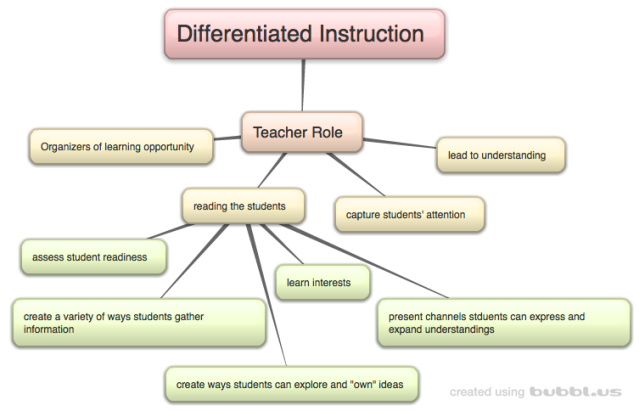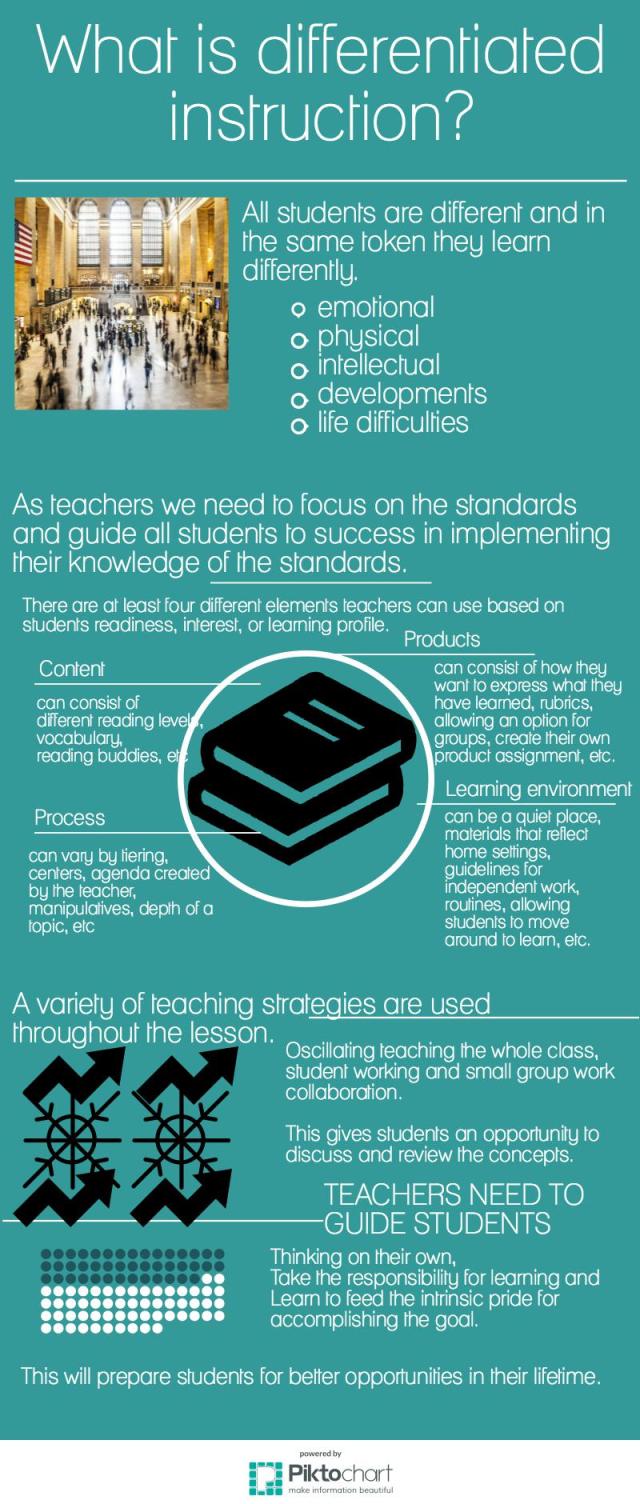
Essential question:
How do you make decisions about your own actions for students in a differentiated classroom? What is your criteria for intervention, and/or for letting learning happen?
I have been teaching over 20 years and I have been through enough training that the two chapters, in How to Differentiate Instruction in Mixed-Ability Classrooms by Carol Tomlinson, was a great reminder of all the different aspects of teaching that I do. I greet the students as they come in to the classroom and I make them feel at home. I try to keep it safe for the students to ask questions. I usually see growth in students through the school year and I have to continually work with others. The most resilient students are the boys that have really good days and really bad days. On their really bad days they usually have to come back to apologize and I address the issue with understanding and accept their apology. They usually have a better time for a longer time knowing they are still welcomed back in class. They also have a better idea of how safe they are in the classroom even though it has rules of respect for all.
I see myself as a facilitator of knowledge and my job is to guide the students through curriculum with an opportunity to be successful. I build scaffolding around them to ensure success as they pour in the effort to learn. I seat them in groups where they will discuss a problem as they work through it. In these groups is where I falter. I have the groups set in stone (not really), but I rearrange the seating in a fashion where there is least disruption. These groups have their mixed by mostly successful in their own groups, they can usually be successful with their task with minimal help. I have two groups that are very dependent on teacher aide guidance. They would not succeed without continual prompting.
I teach at the front of the class and direct them through their assignment. In McCarthy article he suggests Khan academy for math videos, I do use these and other Youtube videos. I post the videos in Google Classroom so they students can view them if they missed a class. If the students are still floundering I stay at the front of the class and teach them to look for patterns in what we are doing. They know I will help them to fly on their own. McCarthy also mentioned Think-Pair-Share and I haven’t used this one in awhile and I need to incorporate it again. The students are more mature and should do better at sharing their thoughts with their peers.
Another DI that the article Methods of Differentiation in the classroom brought up is assessments. I don’t do as well as I would like is to frequently assess the students. I do check their work and success on a daily basis, but I don’t give assessments weekly like I would want to, I will work on changing this.
“When teachers differentiate instruction, they move away from seeing themselves as keepers and dispensers of knowledge and move toward seeing themselves as organizers of learning opportunities.” I love this measuring tool that Tomlinson stated in her book. I have moved into the “organizer of learning opportunities”. This has taken me years to develop through educational classes. I also identify with seeing myself as a coach and giving the responsibility of learning to the students.
When we DI in the classroom we have to be able to use any situation, such as, teach to the whole class, work in groups, or individual work and still know our students as individuals. If a student is struggling with a concept we should know they are. When we have a conversation with a student we are deciphering what the student is struggling with and evaluating their understanding of the concept. Students’ think they are just asking a question, but the teacher is assessing their understanding of the task in front of them. We listen to the vocabulary and the confidence of their disposition to evaluate their understanding while looking for any error in their thinking as we answer their question. Sometimes we answer too much and the knowledgeable student will stop us, because they understood the rest of the concept. They just wanted clarification of what they were proving to their group or it satisfied their insecurity of continuing their work. DI in the classroom is a necessity for all students to be successful. A teacher must know where all the students are at and try to meet their learning language. This is not an easy task.
My criteria for intervention, and/or for letting learning happen in my classroom is stated and posted at the beginning of the year. I continue to hang new encouraging poster that prompt the behavior I would like to promote in my classroom. My theme in my classroom in to be positive, such as, it is a no meanness zone, reach for the stars, goals of success, dancing polar bears due to success in math, etc. When students are learning I give them room to try before I help. I point out the success they have and will give prompts where they are struggling; I will sit with them until I see the anxiety go away. I award their achievement through praise. I do my best to stay positive and use kindness, and by no means am I perfect at this, but I do surprise myself many times when this sweet voice comes out, I wonder where that came from, this is not how I feel. I do believe in my students, I believe they can do the tasks. I have requested two student-aides in one of my classes to ensure success for those who need more attention. During the class time I stay in charge of the class; I don’t allow students to slack off, let alone be disruptive. I do my best to stay fair and listen to distraught students. I take their story to the principal if it merits it. Students know that their assignments must be completed or I’ll return it with only partial credit. I also expect them to grade the assignment first so they can see how they are performing. I also grade it and if it differs greatly I bring it to their attention. When they are grading their papers and they disagree with my answer key they have me do my work again to see who is right. They are happy when it is my error and that they challenged me on the problem and were correct. This is quite an achievement in their eyes, which makes me proud they are thinking through the mathematical rules and challenging with thought.
This is challenging to use DI in the classroom, but with the diversity we have to use DI to help our students to succeed at learning. This is our purpose and DI becomes just a way of life for todays teachers.
References:
Kelly, M. 10 ways teachers can communicate expectations to students. About education. Retrieved January 2016 from http://712educators.about.com/od/motivation/tp/10-Ways-Teachers-Can-Communicate-Expectations-To-Students.htm
McCarthy, J. (2014) 3 Ways to plan for diverse learners: what teachers do. eduTOPIa. Retrieved January 2016 from http://www.edutopia.org/blog/differentiated-instruction-ways-to-plan-john-mccarthy
Methods of differentiation in the classroom. BBC Active. Retrieved January 2016 from http://www.bbcactive.com/BBCActiveIdeasandResources/MethodsofDifferentiationintheClassroom.aspx
Tomlinson, C. (2001) How to differentiate Instruction in mixed-ability classrooms. Association for Supervision & Curriculum Development. ebrary.

